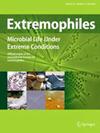基于基因组的 Haloarcula 和 Halomicroarcula 属分类法,并描述了 Haloarcula 的六个新物种。
摘要
Haloarcula 属和 Halomicroarcula 属是 Haloarculaceae(卤杆菌科)中亲缘关系最密切的属。Haloarcula 属各型菌株的 16S rRNA 基因与 Halomicroarcula 属各型菌株的同源基因有 94.7-96.5% 的相似性。Haloarcula 种与 Halomicroarcula 种的 rpoB'基因相似度为 89.3-92.8%。这些相似性高于拟议的属界。系统进化分析表明,这两个属形成了一个紧密的聚类,与半微生物属分开,且引导置信度较高。卤菌属和卤微菌属之间的平均氨基酸同一性(AAI)值为 70.1-74.5%,高于区分卤菌属和卤微菌属的临界值(67.0%)。这些结果表明,应将卤微杆属(Halomicroarcula)与卤杆属(Haloarcula)合并。然后,根据从粗海盐、海水晒盐和盐湖(中国)分离的菌株 DFY41T、GDY20T、SHR3T、XH51T、YJ-61-ST 和 ZS-22-S1T 描述了六个新种。系统进化分析表明,这六个菌株形成了独立的支系(16S rRNA相似度为90.1-99.3%,rpoB'基因相似度为89.0-94.9%),然后与现有的Haloarcula和Halomicroarcula物种聚类(16S rRNA相似度为89.4-99.1%,rpoB'基因相似度为87.6-95.0%)。这六个菌株与目前的 Haloarcula 和 Halomicroarcula 物种之间的平均核苷酸同一性(ANI)、数字 DNA-DNA 杂交(dDDH)和 AAI 值分别为 76.2-89.8%、25.3-46.0% 和 70.3-89.7%,明显低于物种划分阈值。根据表型特征的差异,将这 6 个菌株与现有的 Haloarcula 和 Halomicroarcula 物种区分开来。根据表型特征的差异,将这6株菌株与现有的卤虫和卤微虫区分开来,并提出了6个新种,即卤虫新种(Haloarcula halophila sp.nov.)、卤微虫新种(Haloarcula litorea sp.nov.)、卤微虫新种(Haloarcula rara sp.nov.)、卤微虫新种(Haloarcula halobia sp.nov.)、卤微虫新种(Haloarcula pelagica sp.nov.)和卤微虫新种(Haloarcula ordinaria sp.nov.)。

The genera Haloarcula and Halomicroarcula are the most closely related genera within the family Haloarculaceae (class Halobacteria). The respective 16S rRNA genes of type strains from the genus Haloarcula showed 94.7-96.5% similarities to their homologous genes of type strains from the genus Halomicroarcula. The Haloarcula species showed 89.3-92.8% rpoB' gene similarities to Halomicroarcula species. These similarities were higher than the proposed genus boundary. Phylogenomic analysis revealed that these two genera formed a tight cluster separated from Halomicrobium with high bootstrap confidence. The average amino acid identity (AAI) values among Haloarcula and Halomicroarcula were 70.1-74.5%, higher than the cutoff value (67.0%) to differentiate the genera Haloarcula and Halomicroarcula from Halomicrobium. These results indicated that the genus Halomicroarcula should be merged with Haloarcula. Then, six novel species are described based on strains DFY41T, GDY20T, SHR3T, XH51T, YJ-61-ST, and ZS-22-S1T isolated from coarse sea salt, marine solar saltern, and salt lake (China). These six strains formed separate clades (90.1-99.3% 16S rRNA and 89.0-94.9% rpoB' gene similarities) and then clustered with current Haloarcula and Halomicroarcula species (89.4-99.1% 16S rRNA and 87.6-95.0% rpoB' gene similarities), as revealed by phylogenetic analyses. The average nucleotide identity (ANI), digital DNA-DNA hybridization (dDDH), and AAI values among these six strains and current Haloarcula and Halomicroarcula species were 76.2-89.8%, 25.3-46.0%, and 70.3-89.7%, respectively, clearly below the species demarcation threshold. These six strains were distinguished from current Haloarcula and Halomicroarcula species according to differential phenotypic characteristics. Six novel species, Haloarcula halophila sp. nov., Haloarcula litorea sp. nov., Haloarcula rara sp. nov., Haloarcula halobia sp. nov., Haloarcula pelagica sp. nov., and Haloarcula ordinaria sp. nov., are proposed to accommodate strains DFY41T, GDY20T, SHR3T, XH51T, YJ-61-ST, and ZS-22-S1T, respectively.

 求助内容:
求助内容: 应助结果提醒方式:
应助结果提醒方式:


